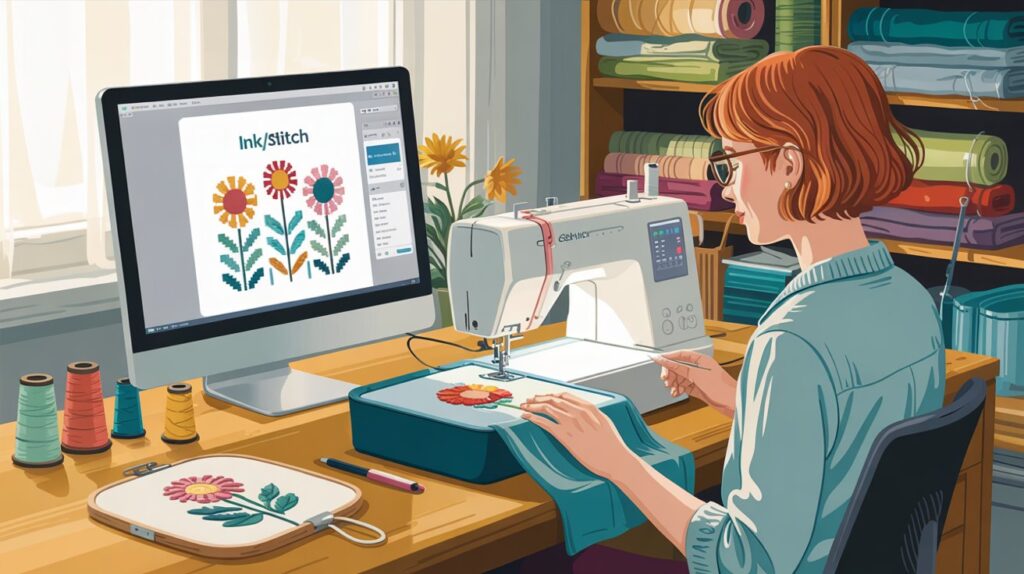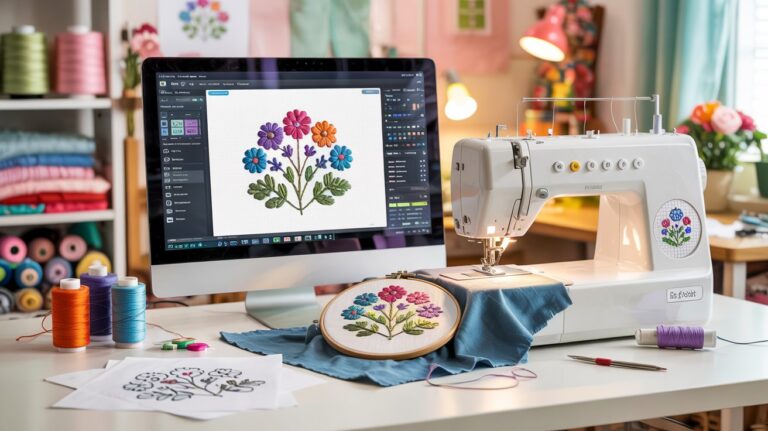Embroidery is a timeless craft that blends creativity with precision, and in 2025, free embroidery software has made it easier than ever to design stunning patterns without breaking the bank. Whether you’re a hobbyist stitching personalized gifts or a professional digitizer creating intricate designs, free embroidery software offers powerful tools to bring your ideas to life. This comprehensive guide explores the best free embroidery software available, their features, limitations, and tips to maximize their potential. By the end, you’ll know exactly which tool suits your needs and how to use it effectively.
Why Free Embroidery Software Matters
Embroidery digitizing software can be expensive, with premium options like Wilcom and Hatch costing hundreds or even thousands of dollars. For beginners, small businesses, or hobbyists, these price tags can be a barrier. Free embroidery software levels the playing field, offering robust features for creating, editing, and converting embroidery designs without upfront costs. These tools are especially valuable for:
- Beginners learning the ropes of digitizing.
- Hobbyists experimenting with designs for personal projects.
- Small businesses testing software before investing in paid versions.
- DIY enthusiasts combining code and art for custom creations.
In 2025, advancements in open-source platforms and community-driven development have made free software more capable than ever. Let’s dive into the top free embroidery software options, their strengths, and how they stack up.

Top Free Embroidery Software in 2025
Here’s a detailed look at the best free embroidery software, based on functionality, ease of use, and community support.
1. Ink/Stitch: The Open-Source Powerhouse
Overview: Ink/Stitch is an open-source extension for Inkscape, a free vector graphics editor. It’s the go-to choice for those seeking a completely free, cross-platform embroidery digitizing solution.
Key Features:
- Design Creation: Convert vector artwork (SVG files) into embroidery designs with stitch types like satin, fill, and zigzag.
- Customization: Adjust stitch density, angles, and patterns for precise control.
- File Compatibility: Supports formats like DST, PES, EXP, JEF, and more, compatible with most home and industrial machines.
- Lettering: Create text-based designs with a variety of fonts.
- Community Support: Extensive tutorials, forums, and a global community of contributors.
- Advanced Tools: Features like tartan patterns, appliqué, and stitch path optimization for professional results.
Pros:
- Completely free with no trial limitations.
- Regular updates from an active open-source community.
- Cross-platform (Windows, Mac, Linux).
- Ideal for both beginners and advanced users willing to learn.
Cons:
- Steeper learning curve due to its reliance on Inkscape.
- Limited built-in font options compared to paid software.
- Manual digitizing requires practice for high-quality results.
Best For: Creative hobbyists, coders, and small businesses looking for a free, customizable platform.
Tip: Start with Ink/Stitch’s beginner tutorials on their official website to master vector-to-embroidery conversion. Experiment with simple shapes before tackling complex designs.
2. My Editor by Wings XP: Simple and Intuitive
Overview: My Editor is a free embroidery software from Wings XP, designed for viewing, editing, and converting embroidery files. It’s perfect for users who need basic functionality without complexity.
Key Features:
- File Viewing: Preview designs with realistic 3D rendering.
- Editing Tools: Resize, rotate, mirror, and adjust thread colors.
- File Conversion: Save designs in multiple formats (PES, DST, EXP, etc.).
- Fabric Preview: Visualize designs on different fabric types.
- Stitch Management: Edit stitch properties like density and sequence.
Pros:
- User-friendly interface, ideal for beginners.
- Lightweight and fast, even on older computers.
- Supports a wide range of file formats.
- No subscription or hidden costs.
Cons:
- Limited digitizing capabilities compared to Ink/Stitch.
- Lacks advanced features like auto-digitizing or lettering.
- Primarily an editing tool, not a full design suite.
Best For: Beginners and casual users who want to tweak existing designs or convert files.
Tip: Use My Editor to preview and adjust free designs downloaded from sites like EmbroideryDesigns.com before stitching them out.
3. SophieSew: Object-Oriented Design
Overview: SophieSew is a free embroidery digitizing software that takes an object-oriented approach, allowing users to build complex designs from simple elements like lines and shapes.
Key Features:
- Design Building: Create designs by combining basic elements (running stitches, fill areas).
- Editing: Scale, rotate, and modify stitch types.
- File Support: Compatible with common formats like PES and DST.
- Manual Digitizing: Offers precise control for custom designs.
Pros:
- Free with no restrictions.
- Lightweight and easy to install.
- Good for learning manual digitizing techniques.
Cons:
- Outdated interface and limited documentation.
- No auto-digitizing or advanced stitch options.
- Less community support compared to Ink/Stitch.
Best For: Users interested in learning manual digitizing on a budget.
Tip: Pair SophieSew with free SVG files from sites like Creative Fabrica to create unique patterns.
4. Embrilliance Express: Free Mode for Basic Needs
Overview: Embrilliance offers a suite of embroidery software, but its free Express mode allows users to view, convert, and print designs without purchasing a license.
Key Features:
- File Conversion: Supports over 30 embroidery file formats.
- Design Viewing: Preview designs with thread colors and stitch counts.
- Printing: Generate templates for precise placement.
- Basic Editing: Limited resizing and rotation in free mode.
Pros:
- Intuitive interface, great for beginners.
- Cross-platform (Windows and Mac).
- Seamless upgrade path to paid versions like Essentials or Enthusiast.
- Reliable support from the Embrilliance team.
Cons:
- Free mode lacks digitizing or advanced editing.
- Requires purchase for full functionality.
- Limited to basic tasks like conversion and preview.
Best For: Users testing Embrilliance before committing to a paid version or those needing simple file management.
Tip: Use Embrilliance Express to organize your design library and convert files for your machine’s format.
5. Embroidery Tool Shed: Free Editing Basics
Overview: Offered by Designs in Machine Embroidery, Embroidery Tool Shed is a free software for basic editing and file management, with demo versions of premium tools.
Key Features:
- Editing: Resize, rotate, mirror, and re-color designs.
- File Support: Reads and writes formats like PES, DST, VP3, and more.
- Design Analysis: View stitch sequences and simulate stitching.
- Hoop Management: Create and adjust hoops for accurate design placement.
Pros:
- Free with no time limit.
- Includes demo access to advanced tools.
- Simple and lightweight for quick edits.
- Cross-platform with Mac support via a translator.
Cons:
- Limited to basic editing without premium upgrades.
- No digitizing capabilities.
- Less robust than Ink/Stitch for design creation.
Best For: Casual embroiderers who need quick edits and file conversions.
Tip: Download Embroidery Tool Shed from InspiredByDime.com and explore its demo features to decide if premium tools are worth the investment.
Comparing Free Embroidery Software
| Software | Digitizing | Editing | File Conversion | Ease of Use | Best For |
| Ink/Stitch | Yes | Advanced | Yes | Moderate | Hobbyists, coders, businesses |
| My Editor | No | Basic | Yes | Easy | Beginners, casual users |
| SophieSew | Yes | Basic | Yes | Moderate | Manual digitizing learners |
| Embrilliance Express | No | Limited | Yes | Easy | File management, testing |
| Embroidery Tool Shed | No | Basic | Yes | Easy | Quick edits, casual users |
Tips for Using Free Embroidery Software Effectively
- Start Simple: Begin with basic designs like monograms or shapes to learn the software’s interface and tools.
- Leverage Tutorials: Ink/Stitch and Embrilliance have extensive online tutorials. YouTube channels like Machine Embroidery Geek also offer step-by-step guides.
- Use Free Designs: Sites like EmbroideryDesigns.com and Designs by JuJu offer free patterns to practice editing and stitching.
- Optimize Settings: Adjust stitch density and tension to match your machine and fabric for professional results.
- Join Communities: Forums like Stitchboard and Reddit’s r/Embroidery provide tips, troubleshooting, and inspiration.
- Combine Tools: Use Inkscape for vector design, then import into Ink/Stitch for embroidery conversion.
- Test Stitch-Outs: Always do a test stitch on scrap fabric to catch errors before committing to your final project.

Limitations of Free Embroidery Software
While free software is powerful, it has some drawbacks compared to premium options like Hatch or Wilcom:
- Learning Curve: Tools like Ink/Stitch require time to master, especially for manual digitizing.
- Limited Features: Auto-digitizing, advanced lettering, and specialized stitch types are often exclusive to paid software.
- Support: Free tools rely on community forums rather than dedicated customer service.
- Performance: Some free programs may lag with large, complex designs on older computers.
For beginners, these limitations are often manageable, but professionals may eventually need to invest in paid software for efficiency and advanced features.
How to Choose the Right Free Embroidery Software
Consider these factors when selecting your software:
- Skill Level: Beginners should opt for My Editor or Embrilliance Express for simplicity. Advanced users can handle Ink/Stitch’s complexity.
- Purpose: Need to create designs from scratch? Choose Ink/Stitch or SophieSew. Just editing? My Editor or Tool Shed will suffice.
- Machine Compatibility: Ensure the software supports your machine’s file format (e.g., PES for Brother, DST for Tajima).
- Computer Specs: Lightweight options like My Editor work well on older systems, while Ink/Stitch requires a decent processor for Inkscape.
- Long-Term Goals: If you plan to upgrade, Embrilliance Express offers a clear path to paid versions.
Future Trends in Free Embroidery Software
In 2025, free embroidery software is evolving rapidly:
- AI Integration: Expect AI-driven tools to simplify auto-digitizing in open-source platforms.
- Cloud Collaboration: Community-driven software like Ink/Stitch may introduce cloud-based design sharing.
- Mobile Apps: Free mobile editors for quick tweaks are gaining traction.
- Expanded Formats: Support for newer machine formats and 3D embroidery techniques is growing.
Staying active in embroidery forums and following developers on platforms like GitHub can keep you ahead of these trends.
Conclusion
Free embroidery software in 2025 offers incredible opportunities for creators of all levels to design, edit, and stitch without financial barriers. Ink/Stitch stands out as the most versatile, combining powerful digitizing with open-source flexibility. My Editor and Embrilliance Express excel for beginners needing simple editing and conversion, while SophieSew and Embroidery Tool Shed cater to niche needs. By understanding their strengths and limitations, you can choose the perfect tool to match your skills and goals.
Whether you’re personalizing a gift or starting a side hustle, these free tools empower you to unleash your creativity. Start with Ink/Stitch for its all-in-one capabilities, explore tutorials to build confidence, and join online communities for inspiration. With practice and the right software, your embroidery projects can rival professional designs—without spending a dime.

